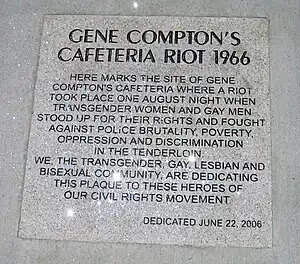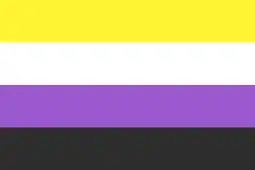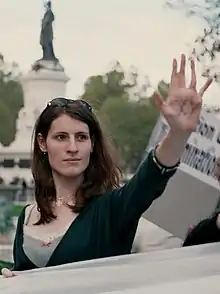The following selected articles appear on Portal:Transgender. The layout for new additions is at Portal:Transgender/Selected article/Layout.
Selected article 1
Portal:Transgender/Selected article/1
Androgyny is the combination of masculine and feminine characteristics into an ambiguous form. Androgyny may be expressed with regard to biological sex, gender identity, gender expression, or sexual identity. The different meanings of androgyny point to the complex interrelationship between aspects of sex, gender, and sexuality. When androgyny refers to mixed biological sex characteristics in humans, it often refers to intersex people. As a gender identity, androgynous individuals may refer to themselves as genderqueer, non-binary, or gender neutral...
Selected article 2
Portal:Transgender/Selected article/2

Two-Spirit (also two spirit or twospirit) refers to Native Americans who fulfill one of many mixed gender roles found traditionally among many North American indigenous groups. Traditionally the roles included wearing the clothing and performing the work of both male and female genders. The term usually implies a masculine spirit and a feminine spirit living in the same body and was coined by contemporary LGBT Native Americans to describe themselves and the traditional roles they are reclaiming. There are many terms for these individuals in various indigenous languages. As of 1991, male and female bodied Two-Spirit people have been "documented in over 130 tribes, in every region of North American, among every type of native culture".
Selected article 3
Portal:Transgender/Selected article/3

The Compton's Cafeteria Riot occurred in August 1966 in the Tenderloin district of San Francisco. This incident was one of the first recorded LGBT-related riots in United States history, along with the Cooper Do-nuts Riot, preceding the more famous 1969 Stonewall Riots in New York City. It marked the beginning of transgender activism in San Francisco.
The 1960s was a critical time period for sexual, gender, and ethnic minorities—social movements which honed in on civil rights and sexual liberation came into fruition, and even churches, like the Glide Memorial Methodist Church in San Francisco, began reaching out to the transgender community. Still, many police officers resisted this change and continued to abuse and ostracize transgender people. This simultaneous rise in support for transgender rights on one side, and the unwillingness to accept these new ideas on the other, created the strain that would fuel the riot at Compton's Cafeteria in the summer of 1966, in which a transgender woman resisted arrest by throwing coffee at a police officer and drag queens poured into the streets, fighting back with their high heels and heavy bags.
Selected article 4
Portal:Transgender/Selected article/4
Transgender hormone therapy of the male-to-female type (MTF), also known as feminizing hormone therapy, is hormone therapy and sex reassignment therapy to change the secondary sexual characteristics of transgender people from masculine (or androgynous) to feminine. It is one of two types of transgender hormone therapy (the other being female-to-male) and is predominantly used to treat transgender women and other transfeminine individuals. Some intersex people also take this form of therapy, according to their personal needs and preferences.
The purpose of the therapy is to cause the development of the secondary sex characteristics of the desired sex, such as breasts and a feminine pattern of hair, fat, and muscle distribution. It cannot undo many of the changes produced by naturally occurring puberty, which may necessitate surgery and other treatments to reverse (see below). The medications used for the MTF therapy include estrogens, antiandrogens, progestogens, and gonadotropin-releasing hormone modulators (GnRH modulators)...
Selected article 5
Portal:Transgender/Selected article/5

Non-binary is a spectrum of gender identities that are not exclusively masculine or exclusively feminine—identities that are outside the gender binary. Genderqueer is an earlier term with the same meaning, originating from queer zines of the 1980s.
Non-binary people may identify as having two or more genders (being bigender or trigender) having no gender (agender, nongendered, genderless, genderfree or neutrois); moving between genders or having a fluctuating gender identity (genderfluid); being third gender or other-gendered (a category that includes those who do not place a name to their gender).
Gender identity is separate from sexual or romantic orientation, and non-binary people have a variety of sexual orientations, just as transgender and cisgender people do.
A non-binary gender is not associated with a specific gender expression, such as androgyny. Non-binary people as a group have a wide variety of gender expressions, and some may reject gender "identities" altogether.
Examples of identities on the non-binary spectrum are demiboy, non-binary, and demigirl. These are not all of them, but probably some of the most common.
Selected article 6
Portal:Transgender/Selected article/6
Third gender or third sex is a concept in which individuals are categorized, either by themselves or by society, as neither man nor woman. It is also a social category present in societies that recognize three or more genders. The term third is usually understood to mean "other"; some anthropologists and sociologists have described fourth, fifth, and "some" genders.
In different cultures, a third or fourth gender may represent very different things. To Native Hawaiians and Tahitians, Māhū is an intermediate state between man and woman, or a "person of indeterminate gender". The traditional Diné of the Southwestern US acknowledge four genders: feminine woman, masculine woman, feminine man, masculine man. The term "third gender" has also been used to describe hijras of India who have gained legal identity, fa'afafine of Polynesia, and sworn virgins of Albania...
Selected article 7
Portal:Transgender/Selected article/7
Gender dysphoria (GD) is the distress a person feels due to their birth-assigned sex and gender not matching their gender identity. People who experience gender dysphoria are typically transgender. Evidence from studies of twins suggests that gender dysphoria not only has psychological causes, but may have biological causes as well.
The diagnostic label gender identity disorder (GID) was used by the DSM until its reclassification as gender dysphoria in 2013, with the release of the DSM-5. The diagnosis was reclassified to better align it with medical understanding of the condition and to remove the stigma associated with the term disorder. The American Psychiatric Association, publisher of the DSM-5, stated that gender nonconformity is not the same thing as gender dysphoria, and that "gender nonconformity is not in itself a mental disorder. The critical element of gender dysphoria is the presence of clinically significant distress associated with the condition." Some transgender people and researchers support declassification of the condition because they say the diagnosis pathologizes gender variance and reinforces the binary model of gender.
Selected article 8
Portal:Transgender/Selected article/8
Gender dysphoria in children, also known as gender identity disorder in children or gender incongruence of childhood, is a formal diagnosis used by psychologists and physicians to describe children who experience significant discontent (gender dysphoria) with their biological sex, assigned gender, or both.
GIDC was formalized in the third revision of the Diagnostic and Statistical Manual of Mental Disorders (DSM-III) in 1980 and primarily referenced gender non-conforming behaviors. GIDC remained in the DSM from 1980 to 2013, when it was replaced with the diagnosis of "gender dysphoria" in the fifth revision (DSM-5), in an effort to diminish the stigma attached to gender variance while maintaining a diagnostic route to gender affirming medical interventions such as hormone therapy and surgery.
Selected article 9
Portal:Transgender/Selected article/9
Transgender hormone therapy of the female-to-male type (FTM), also known as masculinizing hormone therapy, is a form of hormone therapy and sex reassignment therapy which is used to change the secondary sexual characteristics of transgender people from feminine (or androgynous) to masculine. It is one of two types of transgender hormone therapy (the other being male-to-female), and is predominantly used to treat transgender men and other transmasculine individuals. Some intersex people also receive this form of therapy, either starting in childhood to confirm the assigned sex or later if the assignment proves to be incorrect.
The purpose of this form of therapy is to cause the development of the secondary sex characteristics of the desired sex, such as voice deepening and a masculine pattern of hair, fat, and muscle distribution. It cannot undo many of the changes produced by naturally occurring puberty, which may necessitate surgery and other treatments to reverse. The medications used for FTM therapy include, mainly, androgens (namely testosterone) and GnRH analogues...
Selected article 10
Portal:Transgender/Selected article/10
Transitioning is the process of changing one's gender presentation and/or sex characteristics to accord with one's internal sense of gender identity – the idea of what it means to be a man or a woman, or to be non-binary or genderqueer. For genderqueer people, the internal sense of gender identity is neither solely female nor male. For transgender and transsexual people, this process commonly involves reassignment therapy (which may include hormone replacement therapy and sex reassignment surgery), with their gender identity being opposite that of their birth-assigned sex and gender. Transitioning might involve medical treatment, but it does not always involve it. Cross-dressers, drag queens, and drag kings tend not to transition, since their variant gender presentations are (usually) only adopted temporarily. Transition must begin with a personal decision to transition, prompted by the feeling that one's gender identity does not match the sex that one was assigned at birth. One of the most significant parts of transitioning for many transgender people is coming out for the first time...
Selected article 11
Portal:Transgender/Selected article/11
A trans man (sometimes trans-man or transman) is a man who was assigned female at birth. The label of transgender man is not always interchangeable with that of transsexual man, although the two labels are often used in this way. Transgender is an umbrella term that includes different types of gender variant people (including transsexual people). Many trans men choose to undergo surgical or hormonal transition, or both (see sex reassignment therapy), to alter their appearance in a way that aligns with their gender identity or alleviates gender dysphoria.
Selected article 12
Portal:Transgender/Selected article/12

A trans woman (sometimes trans-woman or transwoman) is a woman who was assigned male at birth. Trans women may experience gender dysphoria and may transition; this process commonly includes hormone replacement therapy and sometimes sex reassignment surgery, which can bring immense relief and even resolve gender dysphoria entirely. Trans women may be heterosexual, bisexual, homosexual, asexual, or identify with other terms (such as queer).
The term transgender woman is not always interchangeable with transsexual woman, although the terms are often used interchangeably. Transgender is an umbrella term that includes different types of gender variant people (including transsexual people). Trans women face a vast amount of discrimination (transmisogyny, a subset of transphobia), including in employment and access to housing, and face physical and sexual violence and hate crimes, including from partners; in the United States, discrimination is particularly severe towards trans women who are members of a racial minority, who often face the intersection of transphobia and racism.
Selected article 13
Portal:Transgender/Selected article/13
Multiple countries legally recognize non-binary or third-gender classifications. In some countries, such classifications may only be available to intersex people, born with sex characteristics that "do not fit the typical definitions for male or female bodies". In other countries, they may only (or also) be available to people with gender identities that differ from their sex assigned at birth.
Some non-western societies have long recognized transgender and/or non-binary people as a third gender, though this may not (or may only recently) include formal legal recognition. Among western nations, Australia may have been the first to recognize a third classification...
Selected article 14
Portal:Transgender/Selected article/14
Transphobia is the range of negative attitudes, feelings or actions toward transgender or transsexual people, or toward transsexuality. Transphobia can be emotional disgust, fear, violence, anger, or discomfort felt or expressed towards people who do not conform to society's gender expectation. It is often expressed alongside homophobic views and hence is often considered an aspect of homophobia. Transphobia is a type of prejudice and discrimination similar to racism and sexism, and transgender people of color are often subjected to all three forms of discrimination at once.
Selected article 15
Portal:Transgender/Selected article/15
Boys Don't Cry is a 1999 American biographical film directed by Kimberly Peirce, and co-written by Peirce and Andy Bienen. The film is a dramatization of the real-life story of Brandon Teena (played by Hilary Swank), an American trans man who attempts to find himself and love in Nebraska but falls victim to a brutal hate crime perpetrated by two male acquaintances. The film co-stars Chloë Sevigny as Brandon's girlfriend, Lana Tisdel.
After reading about the case while in college, Peirce conducted extensive research for a screenplay, which she worked on for almost five years. The film focuses on the relationship between Brandon and Lana. The script took dialogue directly from archive footage in the 1998 documentary The Brandon Teena Story. Many actors sought the lead role during a three-year casting process before Swank was cast. Swank was chosen because her personality seemed similar to Brandon's. Most of the film's characters were based on real-life people; others were composites.
Filming occurred during October and November 1998 in the Dallas, Texas area. The producers initially wanted to film in Falls City, Nebraska, where the real-life events had taken place; however, budget constraints meant that principal photography had to occur in Texas. The film's cinematography uses dim and artificial lighting throughout and was influenced by a variety of styles, including neorealism and the films of Martin Scorsese, while the soundtrack consisted primarily of country, blues, and rock music. The film's themes include the nature of romantic and platonic relationships, the causes of violence against LGBT people, especially transgender people, and the relationship among social class, race, and gender. (Full article...)
Selected article 16
Portal:Transgender/Selected article/16
Fierce Femmes and Notorious Liars: A Dangerous Trans Girl's Confabulous Memoir is a 2016 Canadian book by Kai Cheng Thom. A surrealist novel, it follows an unnamed transgender woman protagonist who leaves home at a young age to live on the Street of Miracles—where various sex work takes place—with other "femmes" (trans women). After one of them is killed, others form a gang and begin to attack men on the street.
Thom aimed not to write a traditional transgender memoir targeted at explaining transgender issues to cisgender people, but to write the book that would have helped her as a transgender teenager. Characters are based on people from her life, as are plot points, but they are exaggerated and made surrealist. Two metaphors, those of killer bees living inside her and a Ghost Friend which can make her orgasm, represent after-effects of traumatic abuse.
The novel garnered critical praise and was a finalist for Transgender Fiction at the 29th Lambda Literary Awards. It experienced a resurgence of attention when Emma Watson chose it for her feminist book club, Our Shared Shelf, in 2019.
Selected article 17
Portal:Transgender/Selected article/17
.jpg.webp)
Selected article 18
Portal:Transgender/Selected article/18

This article addresses the history of transgender people in the United States from prior to Western contact until the present. There are a few historical accounts of transgender people that have been present in the land now known as the United States at least since the early 1600s. Before Western contact, some Native American tribes had third gender people whose social roles varied from tribe to tribe. People dressing and living differently from the gender roles typical of their sex assigned at birth and contributing to various aspects of American history and culture have been documented from the 17th century to the present day. In the 20th and 21st centuries, advances in gender-affirming surgery as well as transgender activism have influenced transgender life and the popular perception of transgender people in the United States.
Selected article 19
Portal:Transgender/Selected article/19
Portrayals of transgender people in mass media reflect societal attitudes about transgender identity, and have varied and evolved with public perception and understanding. Media representation, culture industry, and social marginalization all hint at popular culture standards and the applicability and significance to mass culture, even though media depictions represent only a minuscule spectrum of the transgender group, which essentially conveys that those that are shown are the only interpretations and ideas society has of them. However, in 2014, the United States reached a "transgender tipping point", according to Time. At this time, the media visibility of transgender people reached a level higher than seen before. Since then, the number of transgender portrayals across TV platforms has stayed elevated. Research has found that viewing multiple transgender TV characters and stories improves viewers' attitudes toward transgender people and related policies.
Selected article 20
Portal:Transgender/Selected article/20
The participation of transgender people in competitive sports, a traditionally sex-segregated institution, is a controversial issue, particularly the inclusion of transgender women and girls in women's sports.
Opponents argue that transgender women have an unfair advantage over, and may endanger, cisgender women in competitive sports due to sex differences in human physiology, and that these differences are not sufficiently reversed by transgender hormone therapies. Supporters of transgender athletes argue that medically prescribed puberty blockers and estrogen suppress testosterone levels and reduce the muscle mass of transgender women, reducing possible competitive advantages. Supporters also argue that sport, particularly youth sports, is also about belonging, well-being, and socialization of young people. The American Medical Association states that legislation barring trans women from women's sports harms the mental health of transgender people.
The controversy has caused debates regarding sex verification in sports. Since the mid-twentieth century, sports institutions have responded to the participation of transgender women and women suspected to be transgender, male, or intersex by adding eligibility requirements to women's sports variously determined by physical examination, sex chromosomes, and sex hormones. Proponents of such regulations regard them as necessary to ensure fair competition and women's safety. Opponents have criticized such regulations as discriminatory against transgender and intersex women, disproportionately affecting women of color, and as causing violations of medical ethics.